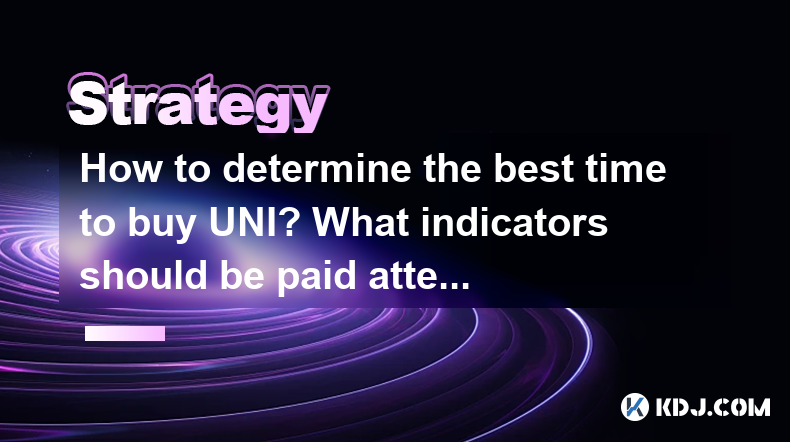-
 bitcoin
bitcoin $121833.232455 USD
-0.63% -
 ethereum
ethereum $4394.437030 USD
-2.00% -
 tether
tether $1.000570 USD
0.04% -
 bnb
bnb $1255.553465 USD
-3.73% -
 xrp
xrp $2.814944 USD
-1.59% -
 solana
solana $221.835346 USD
-2.40% -
 usd-coin
usd-coin $0.999869 USD
0.01% -
 dogecoin
dogecoin $0.249495 USD
-1.32% -
 tron
tron $0.336905 USD
-1.24% -
 cardano
cardano $0.816464 USD
-1.69% -
 chainlink
chainlink $22.130946 USD
-1.27% -
 hyperliquid
hyperliquid $44.208522 USD
-3.46% -
 ethena-usde
ethena-usde $1.000521 USD
0.02% -
 sui
sui $3.422897 USD
-2.51% -
 stellar
stellar $0.380164 USD
-1.31%
How to determine the best time to buy UNI? What indicators should be paid attention to
To find the best time to buy UNI, combine technical analysis (like moving averages and RSI), fundamental factors (such as TVL and governance updates), and market sentiment indicators.
May 01, 2025 at 02:22 pm

Determining the best time to buy UNI, the native token of the Uniswap decentralized exchange, involves a combination of technical analysis, fundamental analysis, and market sentiment. To make informed decisions, it's crucial to understand and monitor various indicators that can signal optimal buying opportunities. This article will guide you through the process of identifying the best time to buy UNI by focusing on key indicators and strategies.
Understanding UNI and Its Market Dynamics
UNI is the governance token of Uniswap, a leading decentralized exchange (DEX) on the Ethereum blockchain. The value of UNI is influenced by the overall performance of Uniswap, the broader cryptocurrency market, and specific events related to the platform. To determine the best time to buy UNI, you need to consider both the token's intrinsic value and external market factors.
Technical Analysis Indicators
Technical analysis involves studying historical price data and market statistics to predict future price movements. Here are some key technical indicators to monitor when considering buying UNI:
Moving Averages (MA): Moving averages help smooth out price data to identify trends. The 50-day and 200-day moving averages are particularly useful. A golden cross (when the 50-day MA crosses above the 200-day MA) can signal a bullish trend, suggesting a good time to buy. Conversely, a death cross (when the 50-day MA crosses below the 200-day MA) might indicate a bearish trend, suggesting caution.
Relative Strength Index (RSI): The RSI measures the speed and change of price movements. An RSI value below 30 indicates that UNI might be oversold, presenting a potential buying opportunity. Conversely, an RSI above 70 suggests that UNI might be overbought, indicating a possible time to wait before buying.
Bollinger Bands: These bands help identify volatility and potential price breakouts. When the price of UNI touches the lower Bollinger Band, it might be a good time to buy, as it could indicate that the price is at a low point and likely to rebound.
Volume: High trading volume can confirm the strength of a price movement. If UNI's price is rising on high volume, it might be a good time to buy, as it suggests strong market interest.
Fundamental Analysis Indicators
Fundamental analysis involves evaluating the intrinsic value of UNI based on the underlying factors affecting Uniswap's performance. Here are some fundamental indicators to consider:
Total Value Locked (TVL): TVL represents the total amount of assets locked in Uniswap's smart contracts. A rising TVL indicates growing user adoption and trust in the platform, which can positively impact UNI's price.
Trading Volume on Uniswap: High trading volume on the Uniswap platform suggests increased activity and liquidity, which can drive up the demand for UNI.
Governance Proposals and Updates: Uniswap's governance model allows UNI holders to vote on proposals that can affect the platform's future. Positive governance outcomes and platform updates can boost UNI's value.
Partnerships and Integrations: Announcements of new partnerships or integrations with other blockchain projects can increase UNI's utility and demand.
Market Sentiment Indicators
Market sentiment reflects the overall attitude of investors towards UNI and the broader cryptocurrency market. Here are some indicators to gauge market sentiment:
Social Media and News: Monitoring social media platforms like Twitter and news outlets can provide insights into current trends and sentiment around UNI. Positive news and increased social media activity can signal a good time to buy.
Crypto Fear and Greed Index: This index measures the market's emotional state. A low fear and greed index might indicate that investors are fearful, potentially presenting a buying opportunity. Conversely, a high index might suggest greed, indicating a time to be cautious.
Sentiment Analysis Tools: Tools like LunarCrush or Santiment can analyze social media data to provide sentiment scores for UNI, helping you understand the general mood of the market.
Combining Indicators for Optimal Timing
To determine the best time to buy UNI, it's essential to combine insights from technical, fundamental, and market sentiment indicators. Here's a step-by-step approach to making a well-informed decision:
Monitor Technical Indicators: Regularly check UNI's moving averages, RSI, Bollinger Bands, and trading volume to identify potential buying opportunities based on price trends and momentum.
Assess Fundamental Factors: Keep an eye on Uniswap's TVL, trading volume, governance proposals, and any new partnerships or integrations that could impact UNI's value.
Evaluate Market Sentiment: Use social media, news, and sentiment analysis tools to gauge the overall mood of the market towards UNI.
Look for Confluence: The best time to buy UNI is when multiple indicators align. For example, if the RSI indicates that UNI is oversold, the 50-day MA is about to cross above the 200-day MA, and there's positive news about Uniswap, it might be an optimal time to buy.
Practical Steps to Buy UNI
Once you've determined that it's a good time to buy UNI, follow these steps to execute your purchase:
Choose a Cryptocurrency Exchange: Select a reputable exchange that supports UNI trading, such as Coinbase, Binance, or Kraken.
Create an Account: If you don't already have an account, sign up on the chosen exchange. Complete the necessary verification steps to comply with KYC (Know Your Customer) requirements.
Deposit Funds: Deposit fiat currency or another cryptocurrency into your exchange account. Ensure you have enough funds to cover the amount of UNI you want to buy.
Place an Order: Navigate to the UNI trading pair (e.g., UNI/USDT or UNI/BTC). Decide whether to place a market order (buy at the current market price) or a limit order (buy at a specified price). Enter the amount of UNI you want to purchase and confirm the order.
Secure Your UNI: Once the purchase is complete, transfer your UNI to a secure wallet, such as a hardware wallet or a reputable software wallet, to protect your investment.
Frequently Asked Questions
Q: Can I use automated trading bots to buy UNI at the best time?A: Yes, automated trading bots can be programmed to execute trades based on specific technical indicators and market conditions. However, it's important to thoroughly test and monitor these bots, as they can be affected by market volatility and unexpected events.
Q: How often should I check the indicators to determine the best time to buy UNI?A: It's advisable to check the indicators at least daily, especially if you're actively trading. For long-term investors, weekly or even monthly checks might be sufficient, depending on your investment strategy.
Q: Are there any specific times of the day or week that are better for buying UNI?A: While there's no definitive answer, some traders believe that buying during off-peak hours (e.g., late at night or early in the morning) can result in better prices due to lower liquidity. However, this can vary based on market conditions and should be considered alongside other indicators.
Q: How can I stay updated on Uniswap's governance proposals and updates?A: You can stay informed by regularly visiting Uniswap's official website, joining their community channels on platforms like Discord or Telegram, and following their official social media accounts. Additionally, subscribing to newsletters from reputable crypto news sources can help you stay updated on relevant developments.
Disclaimer:info@kdj.com
The information provided is not trading advice. kdj.com does not assume any responsibility for any investments made based on the information provided in this article. Cryptocurrencies are highly volatile and it is highly recommended that you invest with caution after thorough research!
If you believe that the content used on this website infringes your copyright, please contact us immediately (info@kdj.com) and we will delete it promptly.
- Kuarden, Binance, and Coinbase: Navigating the Crypto Landscape in Style
- 2025-10-11 00:25:16
- LEGO Batman Turns 20: New Sets Celebrate a Legacy of the Dark Knight
- 2025-10-11 00:25:16
- HEMI, Dominari, and Digital Assets: Bridging Bitcoin to Wall Street, Ya Heard?
- 2025-10-11 00:30:01
- Cryptos, Mandala Chain, Layer 1: A Deep Dive into the KPG Presale and Beyond
- 2025-10-11 00:30:01
- Mandala Chain: Early Investors, Thriving Developer Ecosystem, and Polkadot Potential
- 2025-10-11 00:30:01
- zkSchellingCoin: Revolutionizing Trust-Minimized Data with ZK-Oracles
- 2025-10-11 00:30:17
Related knowledge

Practical parameter settings for a Bitcoin multi-timeframe moving average system
Sep 18,2025 at 10:54pm
Optimizing Timeframe Combinations for Bitcoin Trading1. Selecting appropriate timeframes is crucial when building a multi-timeframe moving average sys...

How can I filter out false breakouts in Dogecoin high-frequency trading?
Sep 22,2025 at 01:00am
Understanding False Breakouts in Dogecoin Trading1. A false breakout occurs when Dogecoin's price appears to move beyond a defined support or resistan...

Techniques for identifying tops and bottoms in the Bitcoin on-chain NVT model
Sep 20,2025 at 07:54pm
Understanding the NVT Model in Bitcoin Analysis1. The Network Value to Transactions (NVT) ratio is often described as the 'P/E ratio' of the cryptocur...

What does the surge in open interest in Bitcoincoin futures mean?
Sep 20,2025 at 11:18pm
Understanding the Surge in Dogecoin Futures Open Interest1. A surge in open interest within Dogecoin futures indicates a growing number of active cont...

How can I use the Ethereum USDT premium to gauge market sentiment?
Sep 18,2025 at 11:55pm
Understanding the Ethereum USDT Premium1. The Ethereum USDT premium refers to the price difference between USDT (Tether) traded on Ethereum-based plat...

What should I do if Ethereum staking yields decline?
Sep 20,2025 at 06:18am
Understanding the Causes Behind Declining Ethereum Staking Yields1. The Ethereum network transitioned to a proof-of-stake consensus mechanism with the...

Practical parameter settings for a Bitcoin multi-timeframe moving average system
Sep 18,2025 at 10:54pm
Optimizing Timeframe Combinations for Bitcoin Trading1. Selecting appropriate timeframes is crucial when building a multi-timeframe moving average sys...

How can I filter out false breakouts in Dogecoin high-frequency trading?
Sep 22,2025 at 01:00am
Understanding False Breakouts in Dogecoin Trading1. A false breakout occurs when Dogecoin's price appears to move beyond a defined support or resistan...

Techniques for identifying tops and bottoms in the Bitcoin on-chain NVT model
Sep 20,2025 at 07:54pm
Understanding the NVT Model in Bitcoin Analysis1. The Network Value to Transactions (NVT) ratio is often described as the 'P/E ratio' of the cryptocur...

What does the surge in open interest in Bitcoincoin futures mean?
Sep 20,2025 at 11:18pm
Understanding the Surge in Dogecoin Futures Open Interest1. A surge in open interest within Dogecoin futures indicates a growing number of active cont...

How can I use the Ethereum USDT premium to gauge market sentiment?
Sep 18,2025 at 11:55pm
Understanding the Ethereum USDT Premium1. The Ethereum USDT premium refers to the price difference between USDT (Tether) traded on Ethereum-based plat...

What should I do if Ethereum staking yields decline?
Sep 20,2025 at 06:18am
Understanding the Causes Behind Declining Ethereum Staking Yields1. The Ethereum network transitioned to a proof-of-stake consensus mechanism with the...
See all articles










































































